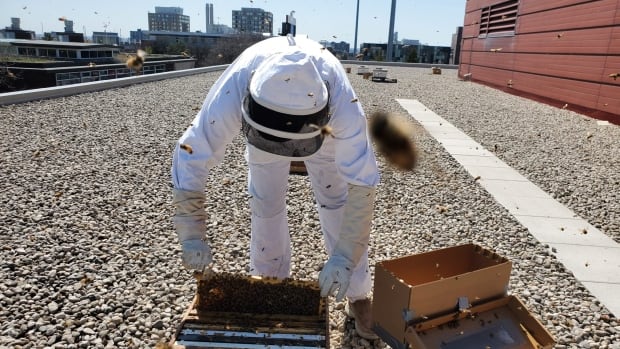They’re vital and they’re threatened. What the public should know on World Bee Day | CBC News
World Bee Day is often a chance to celebrate the hard work bees do to pollinate our plants and keep our ecosystems healthy — but this year, experts say it’s also an opportunity to sound the alarm about the dangers they face, especially after more than two years of COVID-19.
“I’m not really sure how the pandemic helped native bees, but certainly it didn’t help honey bees at all,” said Amro Zayed, a professor of biology and the director of the Bee Ecology, Evolution and Conservation Centre at Toronto’s York University.
These vital insects play a central role in agriculture. In fact, more than a third of the food we eat depends on pollination by bees, either directly or indirectly. But according to experts like Zayed, not only do they face an array of challenges, including pesticides, climate change and habitat loss, the pandemic has also hurt bee populations.
He says public health measures meant to slow the spread of the novel coronavirus have also limited the importation of honey bees, and the hiring of migrant workers, that farms rely on. He says a rise in construction projects during the pandemic has taken away more of the bees’ habitat.
Zayed also says an estimated 50 to 90 per cent of honey bee colonies were lost this year alone due to a harsh winter.
Despite that, he says he’s hopeful for the future since awareness of the problem is more widespread than ever.
“I think the next step is to kind of galvanize that support and actually create better habitats in Ontario, and support legislation that kind of protects bees from pesticides and other stressors.”
How to save the bees
The Bee Ecology, Evolution and Conservation Centre, launched in 2020, has been doing research as well as education, public outreach and policy development.
Some projects include bee colony research to find out how the insects react to problems like viruses and poor nutrition, how to breed at-risk bees to maintain populations, and a program called Bumble Bee Watch, which is a compilation and analysis of photos of bumble bees submitted by citizens — aimed at helping researchers track and conserve bee populations.
To help save the bees, Zayed says people can do things like plant native plants and flowers or “pollinator gardens” on the land they occupy, participate in programs like the Bumble Bee Watch, and try to support legislation that promotes biodiversity, environmental protection, and more transparency about the chemicals used on public land.
Carolyn Davies, the centre’s co-ordinator, says all these projects are exciting to watch and be a part of, no matter how discouraging the end goal of saving the bees may sometimes seem.
“We’ve become this source of knowledge, this source of connection about bees and how bees are important, how we study bees and all the different ways that we do that, and that’s really inspiring.”
For all the latest Technology News Click Here

